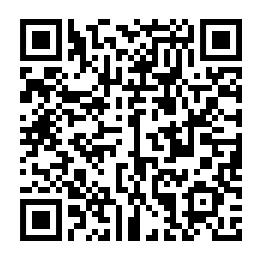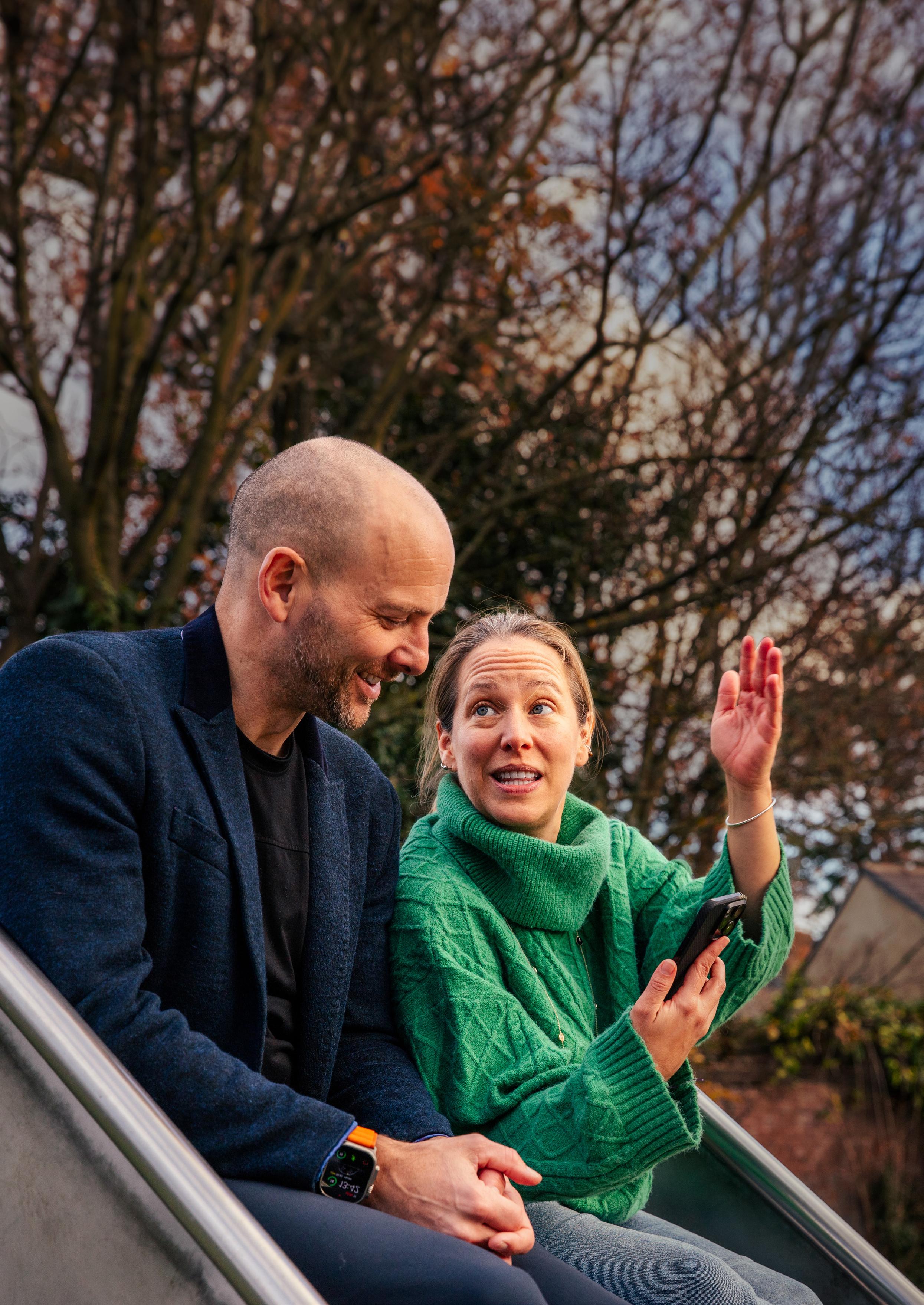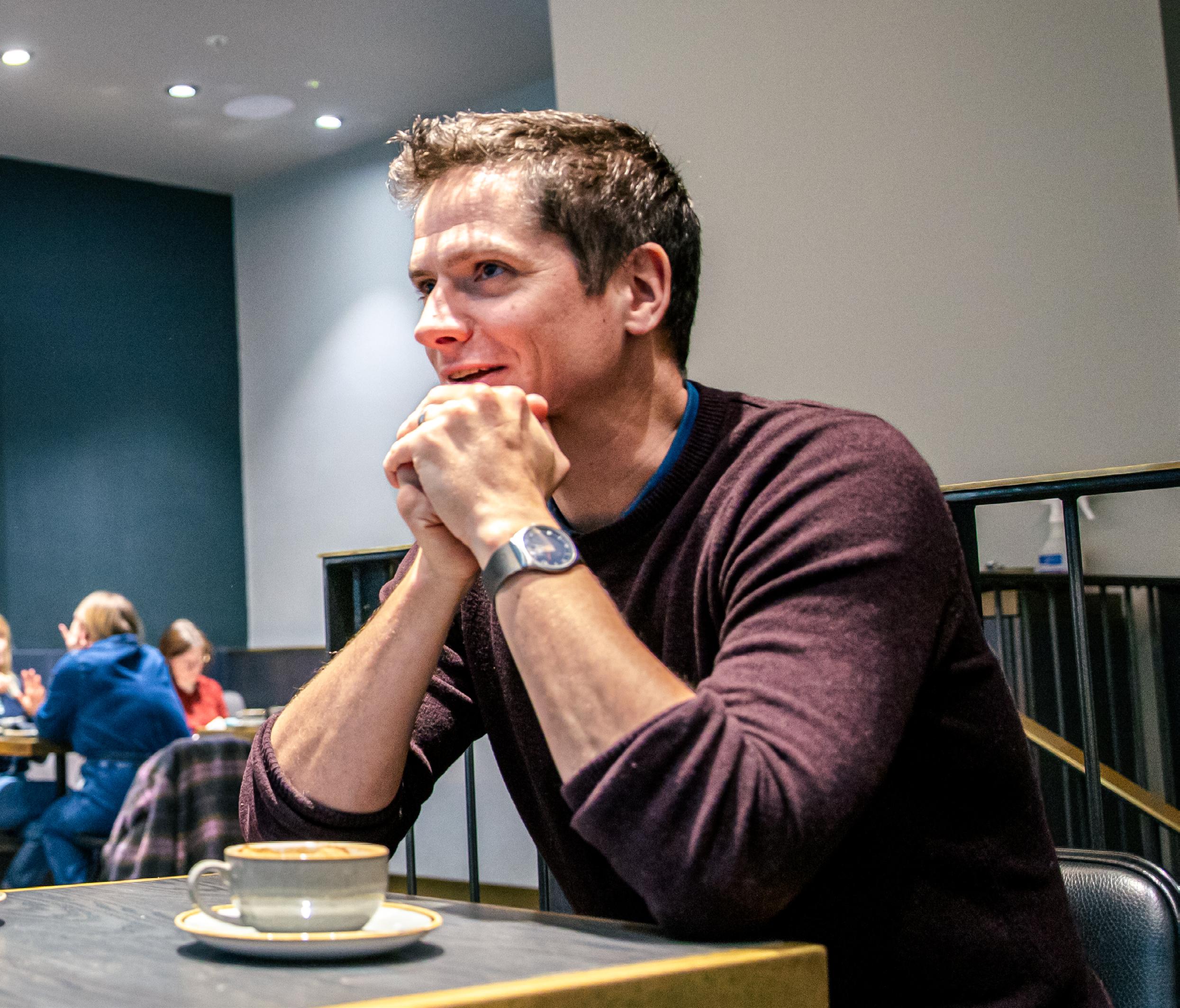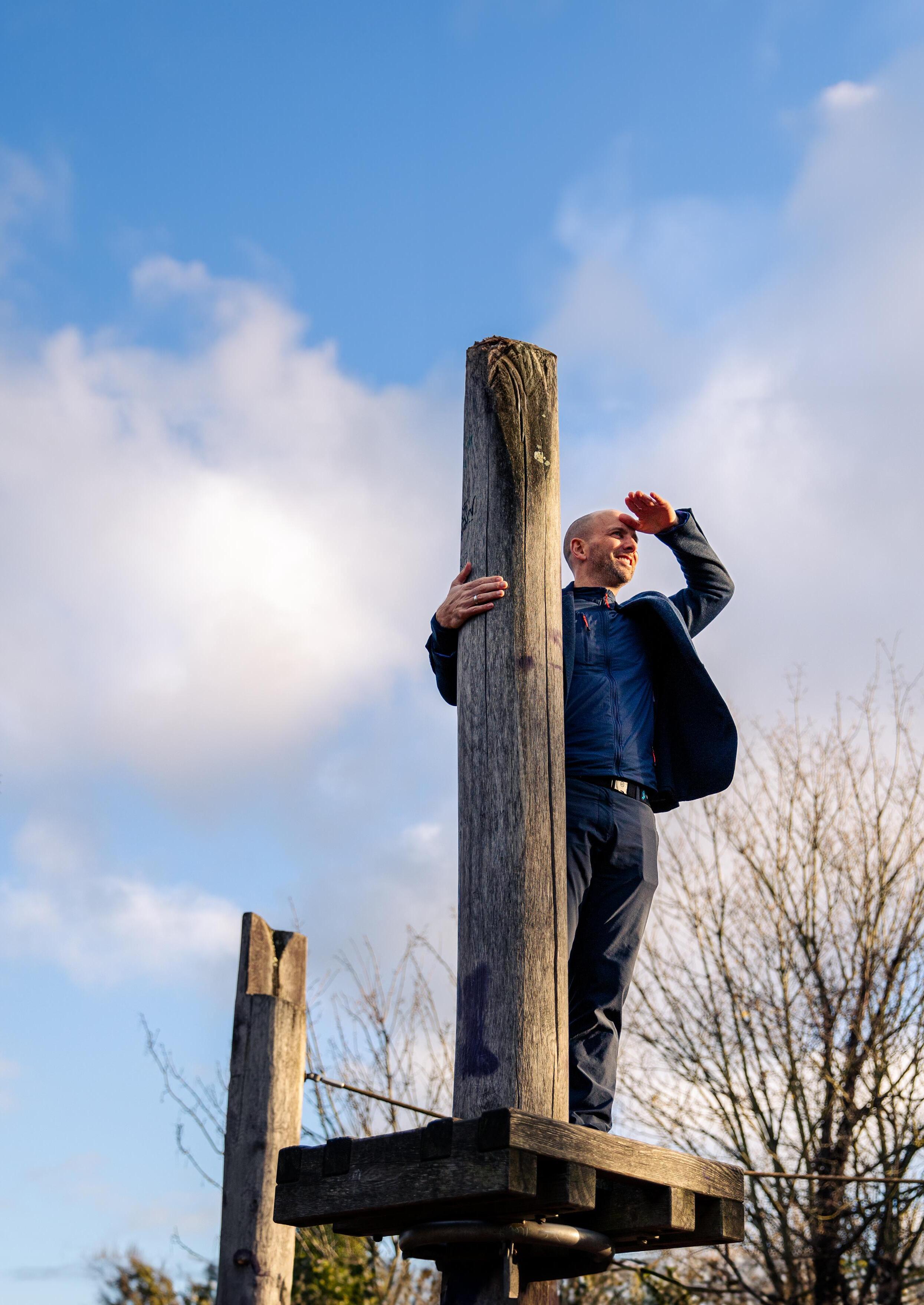FASTER SALES

08
BREADTH VS DEPTH
Should sales enablement be general or specific? 04

DEVELOPING LEADERS OVER SELLERS
The equation for effective and efficient sales teams.
THE WINNING SALES APPROACH
from over 100 years of sales methodology.
Lessons
28 Issue 3 interactiveworkshops.com
Publisher
Interactive Workshops
Contributors
Jess Andrews
Rachel Cise
Milly Gladstone
Emily Link
Nathan Rager
Cody Rowland
Jonna Sercombe
Blair Wagner
Niki Westlake
Editor
Chris Lissaman
Designers
Niki Westlake
Sanda Vieru
Photography
Sam Elwin
Illustration
Gaby Bran
Sanda Vieru
Stock Imagery
Shutterstock Unsplash
Printed in the UK by Blissetts
Unit 1, Shield Drive, West Cross Industrial Park, Great West Road, Brentford, TW8 9EX
A NOTE FROM THE CEO
A warm welcome back to the pages of Imagine Magazine by Interactive Workshops.
Every one of our organisations relies on commercial viability. Sales leaders carry one of the most vital roles in the organisation. In a previous role of mine, one made more than the CEO. They’re that valuable. So, how can we equip and ignite these lucrative assets to our businesses? What’s the secret to accelerating sales?
This issue’s theme is Faster Sales. From the essentials of sales onboarding (p.20), intelligently crafted sales enablement (p.8), nailing an effective sales methodology (p.4), or getting faster investment in sales training (p.46), this magazine is a collection of stories, insights and case studies that put the pedal to the sales metal.
Dip in, leaf through and drop us a message if you want to go faster, together.


Copyright Interactive Workshops © 2024
All rights reserved. No part of this magazine may be reproduced, in whole or in part, without written permission from the publisher. Whilst every effort is made to achieve total accuracy, we cannot be held responsible for any errors or omissions within this magazine.
To work with us please contact: info@interactiveworkshops.com or call Chris Lissaman on +44 (0)20 3318 5753
interactiveworkshops.com
Jonna Sercombe CEO & Founder Interactive Workshops
04
04
THE KEYS TO A WINNING SALES APPROACH
12
08
20
14
26
How a large tech company flipped their sales onboarding programme for team readiness. Features
What sellers can learn from over 100 years of sales methodology.
TO
COMMISSION
OR NOT TO COMMISSION?
We chat to a Sales Development Rep in a non-commission sales role.
28
DEVELOPING LEADERS OVER SELLERS
The simple, misunderstood equation for effective and efficient sales teams.
24
OBSERVING THE OUTCOME
We seek out the key principle that drives an Enablement Director.
BREADTH VS DEPTH
Is effective sales enablement general and broad or specific and deep?
THE ONBOARDING ESSENTIALS
Our guide to unlocking shorter ramp up, faster uptake, and slower attrition.
36
AROUND THE WORLD IN 80 SALES
Reviewing the most interesting places we’ve equipped sales leaders worldwide.
46
FASTER INVESTMENT
This issue’s advice column addresses a thorny issue around sales enablement ROI.
ELEVATE SALES EXCELLENCE
How we increased the production rate of effective upskilling resources by over 500%.
BRIGHTER SALES ONBOARDING
34
BRIGHTER DIGITAL TOOLS
Equipping a world-leading tech company with the digital tools to launch their Sales Methodology.
44
FASTER SALES TRANSFORMATION
Evolving sales onboarding for over 1,500 sales hires in a multinational tech corp.
Also in this issue
CONTENTS
Articles Case Studies
Sales Negotiation...16 | Font of Knowledge...18 | Power of Partnerships...32
05
THE KEYS TO A WINNING SALES APPROACH
Nathan Rager has worked with some of the world’s most famous companies to transform their approach to sales enablement and sales onboarding. Here, he reflects on the various approaches the sales world has adopted to distil three keys to success.
In my experience working with sales teams, from start-up sellers to global tech and engineering sales teams, the most common recurring requirement for success is to be person-centric. Whether a one-person sales lone wolf or a team responsible for delivering million-dollar complex B2B deals, the person-centric approach relies on an ability to effectively build relationships, understand what value means to the customer or client, and concretely show them what can be done to help them to achieve their desired outcome.
It seems obvious, but it is only relatively recently that the accepted ‘way of selling’ has evolved and adapted to this person-centric reality. Of course, there are a wide range of frameworks and tools that can help us do this.
People who have worked in sales and sales enablement for more than a couple of years will be familiar with many of the different ideas that have had their time as the ‘next best thing’ in sales methodology. Let’s recap...
06
The Evolution of Sales
1923
Ford Motor Company
adopts Science of Selling

1930
Brand Based Selling
Advertising was introduced as a way to promote brands and products and to support the selling of products. This surge in advertising led to a new approach to selling called Brand Based Selling.
1936
Relationship Selling
Dale Carnegie's famous book ‘How to Win Friends and Influence People' brought in the era of relationship selling.
1942
SELL Method
S how, E xplain, L ead to Benefit, L et Them Talk
1950
ARCC Method
A sk, Recommend, C ross-Sell, and C lose
1954
AIDA Selling
AIDA is a standardised protocol used by salespeople to grab the Attention of a prospect, encourage an Interest in what the salesperson has to offer, stimulate a D esire to buy, and then generate an A ction; committing to making a purchase from the sales rep.
1929
Mood Selling
Mood Selling was developed by Bible Salesmen who called on prospects door-to-door. With no sales training, most salesmen during this time appealed to emotion to make a sale.
1932
Psychology Selling
Henry Link’s approach was that salespeople should learn basic psychological analysis of their customers in order to learn what made them "tick".
1940
Barrier Selling
Barrier Selling is a method of questioning where the sales person leads the prospect with questions for which the answer is only "Yes".
1946
ADAPT Method
A ssessment, D iscovery, A ctivation, P rojection, Transition
1952
Formula Selling
Formula Selling was a broad approach to several smaller methodologies that came in the 1950s.
1968
Needs Satisfaction Selling
Xerox sales reps were losing deals to the competition. In response, Xerox invested more than $10 million in developing the Needs Satisfaction Selling methodology. The essence of this methodology was that almost nobody wanted to be sold anything, but people did want to make an informed decision.

1972
Xerox Learning Systems
The Xerox method became very successful, which led the Xerox Corporation to create Xerox Learning Systems with the sole purpose of teaching organisations its sales method, which was called Professional Selling Skills.
1985
Strategic Selling
Strategic Selling did not add much value to the process of selling, but it did add additional skills in managing large accounts and how to better navigate complex sales cycles.
1988
SPIN Selling or Consultative Selling
S ituational Questions
P roblem Questions
Implication Questions
N eeds Payoff Questions
2000 Solutions Selling Work with customers to develop a mutual understanding of the solutions that would be a best fit for their problem. Sellers who want to work with buyers is a requirement. Win-win is the goal.
1973
Professional Selling Skills and Needs
Satisfaction Selling
During this time, the Xerox Method was even more formalised and commercialised, used to teach their own internal sales reps, but also packaged so other corporations could use the Xerox method by buying their sales training services from the Xerox Learning Systems.
1986 Miller-Heiman is Organised Miller-Heiman forms their sales consultancy.

1993
Customer Centric Selling
Mike Bosworth, who began his career at Xerox, published a book on Customer Centric Selling. The sales rep relegates their needs to those of the customer. Empowering buyers instead of attempting to sell them, the customer centric approach leads the sales reps to help, rather than just sell.
2011–Present
The Challenger Sale
Developed by the Corporate Executive Board (CEB), sellers challenge customers to think differently about their problem and pre-disposed thinking about the solution. The Sales Rep follows a disciplined Challenger Method choreography.
Source: https://www.membrain.com/blog/a-brief-historyof-modern-sales-methodologies-for-sales-leaders
07
“Consultative selling is an approach that focuses on creating value and trust with a prospect and exploring their needs before offering a solution. The salesperson’s first objective is building a relationship; their second is providing the right product.”
Hubspot
Overall, in spite of some interesting (or questionable) detours along the way, the general progression is (happily) one that is taking us always towards greater transparency, partnership, and collaboration. Of course, how we achieve this varies. One of the great aspects of the Challenger model is that it frames the most successful sellers (in complex B2B scenarios) as those who both know their customers and understand the industry and context so deeply that they are able to lead and guide buyers in their decision-making.
But rather than nail our colours to the mast of the latest Sales Methodology ship to leave the harbour (or any that set sail long ago), let’s ask a simple question… As enablement and learning professionals, what can we do to help our audiences to succeed? From the very personal (it is sales after all) to the more organisational, to the structural. Here are three things I see as key for every seller.
1. Great Questions
It might sound obvious, but even brilliantly high-performing sales people often reflect on how they have fallen into a set of unhealthy habits or patterns. Having the broadest range of questions at our disposal is a vital lever for multiplying our success across different businesses and buyers.
While running foundational questioning approaches with seasoned sales leaders for one global client, the main thing the group remembered was to use open and hypothetical questions to understand the customer context. Even in the biggest organisations, with the very best sales leaders, we can fall into the trap of making assumptions based on our own experience, missing key data.
2. Genuine Curiosity
Harder to train, yet essential to have. All the questions in the world can’t hide a disinterested seller. Curiosity has become something of a company values buzzword, but the reality is that our customers are looking for real human connection first and foremost. A genuine sense of intrigue. If our sellers don’t really want to understand the context and challenges, they won’t succeed.
In our own sales process at Interactive Workshops, we know that if we are genuinely fascinated by what a client does, we are not just more likely to get the sale, but to build a deep and lasting partnership. We also know it’s far easier—and far more successful—to encourage genuine curiosity than to train sellers to fake it. An intriguing fact, connection or story is always there waiting to be uncovered by the curious.
3. Tools on Demand
In the complex world of modern sales, the formulaic approach is increasingly limited. The buyer’s world changes fast. The sellers’ skillsets have to change in sync. At one point in time, an intensive programme could deliver all the sales skills needed for a sales career. Those days are long gone. Modern sellers thrive with easy access to what they need, when they need it.
In a recent examination of a planned refresh of a global sales onboarding programme, our global technology client identified that having invested in a large-scale, role-specific, 4+ week sales onboarding programme, only 7% of targeted hires were completing the structured programme.
In summary, everything has changed (at least a few times over) in the world of sales enablement. But really, nothing much has changed. Whatever framework or model our organisations provide for sellers to structure their approach, it all comes down to doing the basics well. We can put huge amounts of effort into building elaborate solutions, but if we have interested people, asking all the right questions, with easy access to skills and tools content, we’ll sell. And sell real value.
08

“Value selling is a sales technique that focuses on helping prospects understand how a product or service can solve their problems, rather than highlighting the features and specs. In other words—what value will your products or services bring to their lives?”
Zendesk
09
THE TENSION OF SALES ENABLEMENT
BREADTH
There’s a classic tension in any kind of training— should it stay general, or get deep and specific? Sales is no different. Milly Gladstone shares how understanding the unique nature of the sales role helps us handle the tension.
It’s difficult as L&D and Sales Enablement professionals to choose between specific and generic sales enablement. On the one hand, keeping content more generic and skillsfocused gives that space for discussion. On the other, making it specific paves a solid foundation for sellers in a particular function or job role. The trouble is, once we start going down the path of carving job-specific learning, we limit the cohort pool and end up with a web of quitesimilar-but-not-exactly-the-same content.
So, should upskilling happen broadly across a range of sales skills and services, or is it better to have sellers who are product experts?
The truth is, probably a bit of both. Interestingly, sales is unique in that it’s a role that often gets more generalist as seniority increases. Usually, we think of this process being the opposite way round. If we think about a university course, the ‘101’ or introductory course tends to give an overview of everything, and year-by-year—or even degree by degree as students pursue masters’ or PhDs—the specialisms emerge and the knowledge gets deep. That’s how ‘experts’ get such a title. In sales, however, it’s often easier to start salespeople selling one specific product or service. It’s with time and experience that they’re able to branch into other sales areas and widen their knowledge across the business.

10
VS DEPTH

11

12
High
Knowledge over time in most roles
Knowledge over time in typical sales roles
Depth
Low Low High
Breadth
What we do see in the sales training we design and deliver at Interactive Workshops is that it’s the skills that need consistent focus—no matter the experience level of the seller or their deep product knowledge. Sellers have the challenge of building rapport and connection but with the next breath having to bat back negotiations. Of having to reach out and make new connections, then ensure a smooth handover to the customer experience team. They’re constantly having to draw from a broad and varied skillset—and there’s always room for improvement. That’s where L&D comes in.
Below are the top three tips we’ve cultivated from our own experience training sales professionals. See if any of these spark ideas for a sales workshop:
1. Practice Makes Perfect
Even though sellers spend all day on calls or in meetings selling to real-life customers, taking time out to practice is essential. Sharpening the saw and having the space to try out a new elevator pitch, or hone negotiation skills, is well worth the investment. Seeking feedback from the experts or peers who are there can also boost progress in the room.
2. Be Open to New Skills
The world of sales is changing. Consumers don’t want to be ‘sold’ to anymore. Gone are the days of the wheeler-dealer promising anything and everything to get a sale over the line. Instead, buyers—especially in the B2B space—are seeking the long-term benefit a partnership can bring. Staying open-minded in skills training is beneficial, even for the most experienced sellers.
3. Share Knowledge
The intrinsically competitive nature of sales means that the biggest sources of knowledge in companies—the sellers themselves—remain untapped. Some of the best workshops I’ve run give space to share stories and troubleshoot, especially when there are senior salespeople in the room. Chances are, someone has been in that situation before, or has an idea on how to overcome that issue.
13

TO COMMISSION OR NOT TO COMMISSION?
It’s a bold question that some companies are asking themselves. Is a commission-based structure the best way to compensate and motivate sellers? To help answer the question, we asked André Sousa, a Sales Development Representative working in a non-commission role for one of our clients, Discourse. Jess Andrews asks the questions…
14
Firstly, could you give us an overview of your sales experience?
After ten years of experience spanning across various industries, I have mastered B2B/SMB sales, inbound/outbound strategies, and built long-lasting relationships. My expertise ranges from telecommunications, car rentals, hobbies and games, to marketing and software development.
What is the commission structure at Discourse and how does it differ from other places?
This was the first email I received after applying for my current role: “I’d like to send over salary details before we continue the process. I also just want to reiterate that this is a non-commission role and is salary + bonus and equity options. How does that sound?”
Although most salespeople would have been put off by the lack of commission, it was a green flag that meant this was the company for me. While I was used to commission-based models in my previous roles, Discourse does operate differently. We emphasise teamwork and leverage individual strengths, rather than focusing solely on closing deals. Moreover, the ethos at Discourse aligns with my belief that sales should benefit the customer genuinely. Many companies in the past focused solely on closing deals, regardless of the customer’s needs. However, there’s a shift towards prioritising customer value, and Discourse embodies this philosophy by ensuring that our product aligns with the customer’s best interests.
What about that was attractive to you?
Discourse’s sales approach values teamwork and collaboration over individual commissionbased models. By leveraging each team member’s unique skills, we create a more efficient and powerful sales force that provides a tailored experience for our customers.
I’ll give you a practical example. One of my colleagues is excellent at delivering product demos, and by having this structure, we can all benefit from his abilities. If each of us handled the sales process individually, this would not be possible. At Discourse, we focus on each team member’s strengths, allowing them to excel in their roles for the benefit of the entire team.
Are there downsides to this structure?
Although our collaborative model is incredibly empowering, some might miss the direct financial motivation that a commission-based structure offers. Yet, by focusing on our strengths and collective goals, we’ve found this approach remarkably effective in enhancing client engagement, while also providing a safe and healthy environment for the team. We have all heard about toxic competition within sales teams. There’s no such thing at Discourse.
Any recommendations for companies who might want to explore this option?
For companies aspiring to create a robust and collaborative work environment, our model at Discourse is a testament to leveraging team members’ strengths. Emphasising collective success over individual gains has transformed our dynamics, resulting in more cohesive and successful client interactions. It’s also all about nurturing relationships.

For anyone interested in reading more about the Discourse approach to sales, this blog post (QR code to the left) from Hawk, the CEO at Discourse, is very insightful.
Sales development representative at Discourse, André helps online communities thrive by offering a powerful and flexible platform for civilised discourse forums. With over six years of experience in business development and sales across various industries, he has expertise in outbound and inbound sales, B2B and SMB sales, and account management.

15
André Sousa, Sales Development Representative at Discourse
ELEVATE SALES
EXCELLENCE
Our client swiftly addressed an upskilling sales challenge by crafting targeted modules, streamlining to increase production rate from six months to just four weeks.

16
EXCELLENCE
The Challenge
Our client was confronted with a challenge in the swiftly evolving sales landscape, requiring rapid upskilling of their portfolio sellers to embrace a more value-focused mindset, instead of the service-focused sales approach more traditionally used. The urgency centred on orchestrating a quick mindset shift and disseminating crucial information across 10 diverse portfolio topics. Navigating this challenge meant not just adapting but proactively embracing change. Our client aimed to inject energy, fostering an environment where sellers could swiftly absorb and apply evolving insights without feeling overwhelmed. This challenge wasn’t just about overcoming obstacles; it became a pivotal opportunity for our client to demonstrate agility and responsiveness in navigating the shifting tides of the sales domain.
Limited Seller Time
Training must be concise to accommodate sellers’ tight schedules and maximise efficiency.
Mobile-Friendly
Recognising sellers’ mobility, training materials must be easily accessible on phones or tablets.
Engaging Content
To captivate busy sellers, training should incorporate visually appealing and interesting elements for sustained interest.
The Concept
Collaborating closely with our client, our agency held scoping sessions engaging the Head of Services and portfolio leaders. Extracting valuable insights, we proposed a robust template: five eLearning modules accompanied by a digital sales simulation.
The Project
Modules covered diverse areas such as value selling, objection handling, evolving customer needs, and portfolio attributes. This refined blueprint accelerated collaboration with portfolio leads. Impressively, the last portfolio seamlessly progressed from scoping to LMS upload within a four-week span, showcasing agile content development and execution efficiency.
The Impact
Sellers experienced a transformative impact on their skills, mindset, and overall performance. The tailored modules equipped them with practical insights and strategies to use in the field.
This not only enhanced their proficiency in navigating the complexities of the sales landscape but also instilled a heightened sense of confidence. The fully digitised sales simulation allowed them to apply and practise these newly acquired skills in a simulated environment, fostering a hands-on learning experience and cementing learning.
Overall, the training empowered employees with the agility and knowledge needed to excel in their roles, fostering a positive and capable sales force.
17
NEGOTIATING FOR
RESULTS
Negotiation doesn’t need to be the ‘necessary evil’ in the sales process. Leaders and teams can boost sales by embracing negotiation conversations. But how? Blair Wagner shares five plays for next level negotiation.

18
RESULTS

Use Perceived Fairness
Appealing to the other party’s notion of perceived fairness can be useful and help understand what they’re thinking. There are three fairness norms: equality (an even split), equity (a split in proportion to input), and need (a split based on who requires more). Tapping into these norms can give us the basis to present a deal that’s equal for both parties, sell an offering that provides equity to a particular team within the company, or highlight a need that warrants investment.
Utilise Price Anchoring
Everything is relative. A purchase can only be expensive or cheap compared to other purchases. A sale can only ever be “too much” compared to a budget, another seller’s pricing or an expectation of cost. If negotiating on price, try price anchoring. Price anchoring uses a higher price point or range to show the relative value of a lower price point. Consider giving price options or a pricing range for the product or service—that includes an ideal price point. Customers get great value and sellers win the deals at a price that works for all parties.
Leverage the BATNA
For any potential sale, consider the Best Alternative to a Negotiated Agreement (or BATNA). This is the fallback option if things don’t go to plan. That way, we know when to walk away. This framing for the negotiation, even if only ever hypothetical, can completely change the seller’s mindset and attitude in negotiation conversations. Maybe the BATNA is that the seller will be seeing the prospect at an event next week. Plus, we can continue to strengthen our BATNA while negotiation conversations are happening.
Frame it Positively
People feel loss more keenly than they feel gains. Framing our offering with what they might stand to lose by not proceeding with the project has far more weight than going over the features of our offer again and again. If discounts or special offers are being negotiated, positive framing keeps us talking about what we can do, rather than what we can’t.
Create a Win-Win Situation
Instead of either side giving in and compromising, try creating a new, mutually beneficial solution that gives both the seller and the other party something of value. This avoids the pitfall of a tug of war negotiation where neither party will ever truly be satisfied. It’s okay to admit that we could start again. Whilst bold and maybe even a bit radical, this approach can end up with something even better than the original proposition on the table. A win-win situation.
19
FO NT O f L K E O D N E W G Th e
Design in L&D // Volume 2
The world of visual design has so much to teach us about how business and life work. The IW Studio brings this issue’s nugget of wisdom from the creative space.
Why is design important in sales?
Every organisation creates a perception of their brand or product in the eye of the customer. Think of Samsung, for instance. While smartphones, flat-screen TVs or smart fridges may come to mind, so do a sense of dependability and innovation. They are one of the leading technology companies in the industry, and it’s not just because they make a range of great products. They also have fantastic design.
When it comes to sales, graphic design is a very important part of the process. It can sometimes be a ‘make or break’ factor for a purchase. A study from DigiBubble found that a staggering 85% of consumers chose to purchase a product, simply because it had a more appealing design.
I can confidently say I’m often part of the 85%. If a product is designed in a way that is pleasing
to the eye, accessible, and easy to use, this will put it miles ahead of a product that’s not. So a visually appealing product or proposal deck has a competitive advantage for sellers.
With that in mind, here’s a rule to try out: If it’s not designed, it is not completed. No company sets out to ship incomplete products to a customer, and using the rule above, every product, asset, offering, deck, pitch or piece of collateral won’t be shared until it looks brilliant. Whilst sellers are always looking for efficiency to make their numbers, cutting corners on how that proposal deck looks won’t lead to faster sales. (No bid was ever won all thanks to a wordy, colourless PowerPoint.) Why not wow the customer or client with both the concept and the visuals?
Having good design as part of an identity creates trust. And trust is vital to the sale.
The Interactive Workshops Studio is made up of graphic designers, animators and illustrators bringing L&D to life. This creative hub provides intelligently crafted, beautifully designed people development and branding resources: graphics, brochures, posters, books, eLearnings, films, animations and more. If there is a hint of creativity involved, our team can get it done at top speed with enviable attention to detail.
20

Got a short slide deck that needs some visual flair?
Send it to Sanda via the QR above and we’ll make it happen—free of charge.
21
THE ONBOARDING ESSENTIALS

Shorter ramp time, faster uptake, slower attrition. That’s all possible by working out— and working on—the essential components for new sellers. Jess Andrews shares a framework for delivering what matters.
22

When it comes to sales onboarding, organisations are looking to shorten ramp time and reduce attrition for all new hires, whether they are experienced sellers, or early in their career. Even seasoned sellers need the essentials to achieve sales success in their new organisation. It’s tempting to label everything as ‘essential’, but we all know sellers are typically short on time and we want them ‘out there’, selling as quickly as possible. We need to select content carefully.
To add to that, successful sales onboarding goes beyond imparting knowledge—it equips new hires with the tools required to follow internal and external sales processes and provides guidance on where to turn when questions arise.
So, consider this question: what do new hires really need to know in the first week? First 30 days? First 1-3 months? These are the real essentials.
Working Out the Essentials
Usually, it is not just the sellers we need to think about. Programmes need to attend to three key sets of needs—the needs of the new hire, the needs of their manager and the organisational needs. To build something that truly satisfies everyone, establishing and agreeing a set of well-defined competencies that are aligned to the needs and strategy of the business is a good place to start. Break those competencies into behaviours and throw in a dash of evaluation, and we’re off to the races, setting the stage for a seamless integration (if that isn’t mixing my metaphors) into the organisation.
Working On the Essentials
Once we’ve outlined our essentials, here’s a simple but effective way to organise them: The Customer, The Product, The Process and The Team.
The Customer
To really deliver on value-based, customer-centric selling, we must first and foremost understand the customer. Each customer or customer business is unique and will have different, or multiple personas depending on the industry, territory, or product/service. What makes our customers unique? What tools do we have to support new sellers in getting to know their customers?
The Product
Early in the onboarding process, employees should be able to identify and articulate what the organisation sells and what sets it apart from its competitors. Sellers need to be able to communicate the value of their product or service to a range of customer personas. A fun way to practise this could be anything from a cocktail party pitch to elevator pitch, depending on the product or service. How would we explain it, as concisely as possible, to someone who has never heard of it?
The Process Organisations often rely on a process, a methodology or a combination of the two to drive sales success. To support these, they employ a range of tools that new salespeople need to get their heads around. Get new hires up to speed on methodologies and processes quickly. Consider designing experiential learning opportunities using the tools that support the process.
The Team
Sales has historically been viewed as a job for the ‘lone wolf’ but this is changing in many organisations who are moving toward connected teams and a collaborative sales mindset. As such, new hires should be guided on where they add value within the wider sales team, and ideally introduced to their connected team early on. This team will be an invaluable resource.
Once we’ve organised our essentials into those four buckets, then the fun bit: making it happen. We’re helping organisations get their sales onboarding essentials into the hands and minds of their sellers, and creating robust, rigorous and effective programmes. Is yours next?
23
PERILOUS PERFORMANCE PITFALLS

In sales enablement, there are many challenges. Timepoor audiences, fast-changing business goals, sales strategies changing just as we launch the enablement for this year’s strategy. Nathan Rager shares the top five pitfalls Interactive Workshops most frequently helps organisations avoid.
Believing “This” Way is “The” Way
Most sales people with more than a few years of experience have seen at least a couple of hot-off-thepress new sales methods rolled out. Overzealous enablement messaging of “this is the way!”, like it’s a silver bullet, can immediately disengage our most experienced sellers. A more adult-to-adult “here are some tools and thoughts” approach acknowledges the experience in the room and that people will use and adapt what we provide.
Under Engineering
High-growth companies are twice as likely to provide customised training for their employees, depending on their sales roles. 1
While volume and scale count for a lot, the numbers show that enablement, which is targeted and tailored to specific roles, can be a high-impact driver of success. The right effort to understand the audience is key.
24

Over Engineering
While important to note the above, we need the right balance. Tailoring is great, as long as we keep the big picture value mindset central to our planning. In one project with an Interactive Workshops sales enablement client, we spent some time examining the cost and benefit calculations of tailoring pathways to specific roles. In some cases, the value was clear. In others, we identified that accepted “essential” role pathways might only be used by three or four individuals per year. Tailor the investment as well as the content.
Intervention Over Continuation
For the majority of sales professionals, 84% of their sales training is forgotten within three months.2 In a shifting landscape of business goals and strategic priorities, we can get wrapped up in the current zeitgeist, the strategy for now. This is important, but it shouldn’t prevent us from building for the long-term. Modular content that can adapt as goals shift enables reiteration of core messages without the strain of rebuilding every quarter.
Failing to Plan (Means Failing to Measure)
Sales training reaps a staggering 353% ROI for the average company. 3 Despite the above stat, people still believe that “you can’t measure the impact of enablement directly”. Time and time again, clients approach us to work out how to measure the impact of their already deployed programmes. The answer? Build it with measurement in mind. If we start delivering an enablement solution without identifying very explicitly what metric the business wants to see changed, then we will always be playing catch-up. A measurement-first approach makes it easy in the end.
Sources: 1 Uplead, 2 Spotio 3 Task Drive 25

OBSERVING THE OUTCOME
We spoke to Enablement Director at Sequoia, Angie Stuart, about her favourite sales enablement projects and the principles behind her work. Nathan Rager asks the questions.
26

Firstly, could you describe your typical working week?
Doing all I can to connect the dots cross-functionally and gather the stories that will enable our client-facing team members to create extraordinary value for clients and prospects with Sequoia’s tech-enabled advisory solutions.
What do you do in your free time outside of work?
I am raising two busy teens who make me a better person every day. In my spare time I enjoy good food, a good book, comedy shows, and exploring the New England coastline.
Tell us about the best sales enablement project you’ve worked on. Why does it stand out?
I am loving my current project—enabling client-facing team members to bring new Total Compensation and Benefits solutions to our clients. It is standing out because I believe in what we do, the strong relationships we build, and the story we can tell. It’s rewarding to work with such a strong team committed to both each other and our clients.
What traps and pitfalls do you see most often in sales enablement? How can we avoid them?
Building around the product instead of the client is a common mistake. To avoid this, focus on business outcomes with real client examples, and teach the art of storytelling. Enable teams with real client stories they can retell, and complete ‘Show you know’ style activites—such as role plays and certifications, with real client profiles from their own book of business, not canned scenarios.
Are you able to share the key principles you follow when you’re designing sales enablement content?
I focus on the outcome—the observable, measurable behaviours that will lead to success. It’s difficult to track how much knowledge someone is absorbing, or see what they understand, but focusing on an outcome you can observe and measure helps target and gauge effectiveness of enablement efforts.
If you had to create a sales enablement slogan in 10 words or less, what would it be?
Inspire natural conversations with real client stories!

With a background in product management, product marketing, and change management, Angie has spent the last 5 years in Sales Enablement leadership roles at Enterprise Technology and Consulting firms. Helping them transform their go-to-market model and evolve with the ever-changing landscape of technology and culture.
Angie Stuart, Enablement Director at Sequoia
27
BRIGHTER SALES ONBOARDING
We partnered with a large technology company to transform their sales onboarding through innovative learning practices, practical application, and comprehensive assessment.
The Challenge
The client expressed a need to revamp their existing internal sales and success onboarding programme. They sought a shift from asynchronous learning to a more captivating hybrid programme.
The challenge lay in transitioning from a focus on lecture-style learning and knowledge download sessions to implementing a programme that struck a balance between knowledge-based tasks and practical application.
The overall goal? To ensure the sales team’s readiness in their respective roles by fostering confidence among managers and new hires in effectively selling and supporting the product.
Fragmented Offering
An asynchronous onboarding with less interactive learning, focused on multiple non-practical lecture-style trainings that tick onboarding boxes without building sales confidence and readiness.
Limited Engagement
With people participating in learning across three different geographic locations, in a remote setting, the scheduling, logistical and language issues can result in a decline in participant engagement.
Inadequate Assessment
Onboarding assessments that are composed of mostly “Show you Know” evaluations can lack practical applications relevant to individual roles.
The Concept
We proposed to achieve our goal through flipped learning content, embedded evaluation assessment and slick, aligned branding.
Flipped Content
In collaboration with the client, we flipped the learning and content. Flipped learning allows participants to digest and process learning before meeting with experts to practice and ask questions. This involved revamping the original programme into four distinct learning modules, including new task-based eLearnings to be completed before individuals attended facilitated, practice-based workshops.
Embedded Assessment
We changed the assessment by embedding evaluation components throughout the modules. The introduction of a certification workbook within the four key modules ensured ongoing and relevant assessment of participants’ understanding and application of sales concepts. This approach not only enhanced the assessment process but also provided a tangible measure of the participants’ readiness for their sales roles.
Aligned Branding
In addition to reimagining the programme’s content, we introduced consistent branding for the onboarding hub and the associated modules. The new and updated visuals aligned with the new engaging hybrid model. This resonated with the participants and contributed to a more cohesive and memorable learning experience throughout the programme.
28
2 quizzes
25 training hours
6 one cer tification workbook
THE NUMBERS assets
eLearning courses one hub central onboarding
2 assessments
created for all learners, facilitators & managers
5 practice-based instructor-led workshops rebranded
50 over per par ticipant including role-play and scenario-based practical application
What they said:
“Interactive Workshops was quick to learn our business and provide valuable input in the areas of strategy, design, and implementation. Working with Interactive Workshops feels like you have a powerhouse of A-players supplementing your team. Not only do they provide quality work, they are a delight to work with. I look forward to working with the Interactive Workshops team again!”

29
DEVELOPING OVER SELLERS LEADERS

30

LEADERS
Want more sales? Develop better leaders, not better sellers leading sellers. Through hands-on experience and working with some of the best leaders in the world, Cody Rowland tells us why.
Sales and revenue growth are in every for-profit organisation’s goals every year. Some companies ride industry trends to achieve growth, some time the market right, and others just get plain lucky. But there are teams and organisations that consistently manufacture growth, regardless of most external factors. How do they do it?
The easy answer is that their sales reps are better trained. One study has shown that companies that implement a sales training programme can lead to sales figures that are 10% higher than comparable of companies without a sales training programme. 1 Another study showed that sales training programmes can increase individual sellers performance by 20%2 . And the list of studies could go on and on. For most of us, this formula passes the most basic ‘smell test’:
Better sellers = better results
But this oversimplification can lead to a major oversight when searching for the real answer as to how some teams routinely beat quotas and drive growth.
The best sales teams are the result of great leadership, not just great sellers.
One study rated all the sales leaders in an organisation in overall leadership effectiveness. They then looked at the sales results of the sellers working for each of those leaders. The results were astounding. They found that sellers that worked under a sales leader rated in the top 10% of their company had sales results that were, on average, more than six times higher than sellers working for leaders in the bottom 10%. 3
31
Another study showed that 69% of sellers that sold more than their quota rated their sales manager as being “excellent” or “above average.”4
So our formula for more growth is shaping up as follows:
Better sales leaders = better sellers = better results
While this also passes our ‘smell test’ there is a flaw in this formula that far too many sales leaders and organisations overlook. The problem is in the title of “sales leader”. Too many sales leaders and organisations focus on developing better sales leaders, and not enough focus simply on developing better leaders.
Is it just semantics? Not according to the Peter Principles. Named for the late Laurence J Peter (Ed.D., Washington), this theory broadly states that employees are promoted one level beyond where they have proved to be competent. This phenomenon plays out in many functions where specialised skillsets are required to perform at a high level. For example, a highly competent individual contributor that is routinely rated as a “top performer” will most likely get promoted to a position where they are now leading the team doing the work, rather than doing the work themselves. But they were promoted due to past performance (not an accurate predictor of future success) and their performance in another job. They weren’t prompted for being a good leader, they were promoted for delivering results as an individual contributor.


Now that they are leading the team, many new leaders focus on leveraging their technical or functional knowledge. They may even misapply strengths-based development concepts and double down on the skills and knowledge that helped them be successful in the past. The best will even try to transfer those skills and knowledge to their team (on the logic that better trained sellers = more sales). But in so doing, they are focusing on the wrong word in their title: sales. They’d achieve better results by focusing on simply being an effective leader irrespective of function. Teams need the best leaders to get the best out of them, not the best sellers.
32

“The best sales teams are the result of great leadership, not just great sellers.”
And this leads us to one final question: if it’s the best leaders we need, what do those leaders do? While there are many leadership competency models out there, we at Interactive Workshops routinely use the following model:
Eight Key Leadership Qualities
Genuine charisma
People want to work for me and with me. I lead through influence rather than position.
People I lead feel they have autonomy, support, and feel positively stretched.
I’m not just ‘great at my job’. Not just an expert doer. I’m genuinely great at managing and leading people.
Empowerment Managerial competence Decisiveness
Even in ambiguity I can make decisions. If I see people need direction, I will step up and give it.
Passion for the company / work / brand / team.
My word can be trusted. People see the real me.
I’m clear and concise. I readily give praise and don’t shy away from difficult messages.
Sincere enthusiasm Integrity Great communication Loyalty
I have my team’s and my colleagues’ backs. People see and know I’m in this for the right reasons.
We’ve found that leaders that focus on making improvements in these eight areas will see a meaningful improvement in their overall leadership effectiveness, regardless of what function or industry they are in. But specifically for sales leaders, these eight qualities can be the guide for transforming an excellent seller into a leader. And this transformation will unlock the potential of the team to deliver the needed sales growth.
So, we can finish our equation:
Better (sales) leaders = better sellers = better results
The AMP Leadership Assessment is one of the many applications of AMP by Interactive Workshops. AMP is a targeted tool for taking the pulse of your ambition. Rate current performance and future ambition and get a personalised AMP Report.
Try out AMP for yourself here:

Sources:
1 http s://www.td.org/professional-partner-content/how-to-increase-salesthrough-effective-training-programs-in-elearning,
2 https://www.dooly.ai/blog/sales-training-statistics/
3 https://zengerfolkman.com/wp-content/uploads/2019/11/Better-SalesLeaders-Better-Results_WP-2019.pdf
4 https://hbr.org/2015/09/the-7-attributes-of-the-most-effective-sales-leaders
33

THE POWER OF PARTNERSHIPS: THE MILLIONDOLLAR SECRET
Why is selling so often a solo activity? A few individual targets are set and then there’s a whole lot of “getting my boss in on the meeting”. Selling as duos enables a team approach with complementary strengths in meetings, accountability and collaboration outside of sales meetings. Jonna Sercombe and Rachel Cise share their million-dollar secret.
34

How did you meet and when did you decide to work in partnership?
Rachel: We first met during my interviews for Interactive Workshops. Jonna was involved in some aspects. I guess at an interview we are selling ourselves, and the company is selling themselves to the candidates. So, we were selling to each other from day one.
Jonna: In our candidate selection we firstly look for brilliant people. Rachel is extremely grounded and I liked that she had a philosophy background. Clear thinking is so fundamental to high performance, as is building logical arguments. We hired Rachel so I guess she sold to the C-suite pretty well.
What makes your partnership work?
J: I think our relationship is extremely natural and respectful. Sometimes we have a laugh, but we also focus really hard on getting our clients to love what we do, and Rachel is very natural in the client environment. I also find with some team members that there is too much of a power differential between us for it to be an equal partnership, but Rachel always acts as a peer which means we can be a team.
R: In the client environment it’s always clear that I will be taking the lead on running the project, running the deal process, making things happen. Not just in theory, but day to day. I want our clients to have full trust that I will work hard to get everything they need sorted to a high standard. Jonna is involved in both ideas, but also strategising.
J: Yeah, you can’t sell in a paint-by-numbers way. Between us, we both use empathy skills to try to understand what’s really going on, what the real need is, and get a read on how we are doing. I think we are both quite happy being up front about challenges with the client and then solving them collectively.
Is your relationship stable or unstable?
J: Our relationship is stable, level and calm. That’s not at all the case with all the people I work with and I wouldn’t want that with everybody. It’s a very professional approach on both sides.
R: Agreed. A shared value set around quality, thought processes, respect, hard work, and creative brilliance. I really enjoy being in that kind of team. We have bid on and won millions of pounds of work as a duo, so I guess we can say that the approach is successful.
How do you run a deal?
J: Our selling style is highly collaborative. We don’t work on many “tenders” but we do work on some really big deals that need large amounts of excel. My approach to any sale is that there needs to be the seeds of brilliance conceptually and that’s the bit I try to put in. That plus speed.
R: I’m good on attention to detail, process, getting the documents to look perfect, sorting the planning… I love the conversations in the meetings, and then the thought process after. Jonna is great at the meetings but also goes off and scribbles really bad diagrams with terrible writing that I somehow have to turn into a concept. Shall we call it creative tension?
Finally, what annoys you most about the other person? Would you survive on a desert island?
R: Jonna has a limited attention span which could be problematic to our survival. There would be no selling to do. Practically it would probably be fine; I know Jonna is outdoorsy. We both like singing, so maybe that would be a shared point of entertainment.
J: Rachel is very, very cunning at innocently getting other people to do stuff she doesn’t want to do. I’m fearful that without even realising it, I would end up doing all the bad, hard or dirty jobs. The worst part is her influencing skills mean I’d probably even be happy to do them. Now that I’ve thought about it, I need to be more switched on about this at work as I’m probably being exploited without knowing.
35
BRIGHTER DIGITAL TOOLS
We helped our client’s Global Sales Enablement Team launch their new Sales Methodology at their global Sales Conference with bespoke digital tools.
Our client is a multinational technology company, based in San Jose, California. They develop, manufacture, and sell networking hardware, software, and other technology services and equipment.
The Challenge
Our client’s global sales conference brings 20,000 sellers and sales partners together in one location to network, connect, and launch any new technology that will be available across the next year. The Global Sales Enablement Team (gSET) had a room within the venue to launch their sales methodology to this audience. Available to them were seven stands, for them to share information about the seven crucial ‘Moments’ in the methodology.
We were challenged to help gSET make an impact at the event. Our client chose Interactive Workshops for visually stunning assets that would draw sellers to the stands and highlight the key skills of each Moment within the framework. The caveat? Nothing could be physically printed or distributed, in line with the conference’s sustainability commitments.
The Concept
We proposed a multi-media feast, where sellers could consume and engage with the skills in a way that suited them. To fit in with the cutting-edge technology of our client, our goal was to build original content that would push the boundaries of what had ever been seen before at the event. We outlined a suite of highly interactive, intelligently developed and engaging digital tools, including mobile games, a purpose-built diagnostic tool, animations, and a mobile-friendly eBook.
“A bespoke eBook, animations, and diagnostic tool are now permanent assets on our system .”
The Project
We worked collaboratively with the gSET team to narrow down the key messages from each ‘Moment’ of the methodology.
Using agile working teams, we set up several streams to produce assets simultaneously. For the animations, Interactive Workshops’ in-house animation team created concepts for each Moment, which we shared and validated with the main stakeholders. We realised that—in a huge conference centre with thousands of sellers— these videos would have to be purely visual, as no voiceover would be able to be heard. This meant carefully navigating the balance of visuals and text to create an eye-catching yet informative end product.
Similarly, with the mobile games, our developers worked through ideas for each Moment that drew out the landing messages. One of the resulting games involved driving through “accelerators”, which would display advice on how to speed up the deal, and avoiding “blockers”, which not only slowed the car down, but also showed a message detailing how certain events could bring a deal to a screeching halt.
To create the eBook, our graphic designers worked closely with the content creators to present their words in a way that would be visually stunning. At a conference, we acknowledged that sellers would most likely be accessing the eBook on their phones, rather than on laptops, meaning the eBook had to display all the relevant information, without leaving sellers scrolling endlessly. The final product was beautifully designed and economically worded.
The diagnostic tool was the final piece of the puzzle, designed to help sellers identify which Moment of the methodology they should focus on first. After identifying the typical pain points of sellers that sought to solve, our team figured out the most logical pathway users could take, whilst using the fewest number of clicks to increase usability.
The Impact
The nature of digital assets made for a timeless giveaway from the event. Rather than a flyer to be put in a tote bag and discarded later, a bespoke eBook, animations, and diagnostic tool are now permanent assets on our client’s system. Sellers can delve into the content again and again, at a time and place that suits them.
36

37 THE NUMBERS 7 4,753 450 animated videos eBook lines of code 0101010101010101010011001010101 0101010101010101010011001010100101 0101010101010100110010101001010101 games users seven one APP 1 one diagnostic tool
AROUND THE WORLD

38
AROUND WORLD IN 80 SALES

We’ve been fortunate enough to deliver sales enablement in a lot of intriguing places around the world. We fancy ourselves as travel connoisseurs here at Interactive Workshops, so we’ve rounded up some of the best places we’ve facilitated around the world to provide some recommendations…
39

Intercontinental Miami
Jess Andrews
What We Loved
The huge complex of meeting rooms on a plush mezzanine floor. All the space you can imagine for breakouts, with enough room to host hundreds in the main conference room.
Quality of Accommodation
4/5
Overall very good. Access to a gym, swimming pool, and very large, comfortable beds to rest after a hard day of sales enablement. Just one point knocked off on account of the unlucky Interactive Workshops Producer who had a leak through their bathroom light.
Ease of Access
4/5
An easy 15-minute drive from Miami airport in the city’s business district. Pick a convertible and grab a Starbucks for the full Miami highway experience. Plus, there’s a train station across the road, too.
Food Safety Rating
5/5
Very safe.
Wildness Experience
2/5
Despite our best efforts to spot some ‘gators (imagine a bike ride through the Everglades national park and stopping to investigate every ripple in the waters), the closest we got was a metal statue outside the toilets.
Camiral Golf and Wellness –Barcelona
Milly Gladstone
What We Loved
Being on a golf course in the sunshine—sales enablement doesn’t get much better than that.
Quality of Accommodation
4/5
Tastefully decorated communal areas and fruity water in reception lets you know you’re in a wellness hotspot. Sensibly sized rooms, lots of outdoor terrace space, and a nice-sized pool to get some morning lengths in.
Ease of Access
Just over an hour away from Barcelona airport and no public transport means travel by car is a must. The hotel does offer a shuttle service, though.
Food Safety Rating
Wellness status ensures all the food is nutritionally dense and balanced. Allergen labelling keeps it extra safe.
Wildness Experience
3/5 5/5 1/5
We’re not sure what the opposite of wildness is, but a golf course is probably as close as you can get.

40
Agros in Cappadocia – Turkey
Emily Link
What We Loved
We arrived late at night so it was dark, and we were oblivious to the incredible views outside. In the morning, I awoke to an unusual noise of hot air balloons flying outside and opened my window to the most spectacular view. I’m not often speechless, but I was then.
Quality of Accommodation
5/5
Check out the website. I don’t need to say anymore. Seeing is believing.

Ease of Access
2/5
Not the easiest to get to. It requires an additional flight from Istanbul and a coach trip; but worth it. The landscape itself is not very accessibility friendly.
Food Safety Rating
5/5
The food was delicious.
Wildness Experience
4/5
The area is known for its distinctive “fairy chimneys”, tall, cone-shaped rock formations, and stunning scenery. Check it out.
Da Lat – Vietnam
Nathan Rager
What We Loved
Bumping into an elephant on a morning jog.
Quality of Accommodation
5/5
Picturesque villas spread around a lake for a quiet retreat from the bustle of a high-intensity sales bootcamp. Great venue, rooms, and an extremely supportive events team.
Ease of Access
3/5
Internal flight required from Ho Chi Minh or Hanoi, followed by a drive into the mountains. So, a bit of a trek for international groups, but the scenery is a big payoff...
Food Safety Rating
4/5
Incredible local options for the adventurous seasoned traveller. Moderate risk for the more cautious diner.
Wildness Experience
5/5
See elephants below. High altitude so, if exercising, don’t be surprised by increased breathlessness. Especially when being chased by very large and colourful hornets.

41

THE BASIS FOR A BOOTCAMP
What can we learn from over a decade working with sales people? A lot, it turns out. Drawing our own insights from reported challenges, we sought the solution. Jonna Sercombe argues the case for a BootCamp...
42
What We’ve Heard
Working with more than 70 sales leaders from one company for over a decade, we’ve heard the same challenges again and again from sales managers of all levels...
A. Our sales managers become reactive because of issues with not finding the best staff.
B. Our sales managers get involved in hitting targets through selling themselves.
C. Our sales managers invest too much time managing underproductive people.
D. Our success rate in hiring the right people is too low.
E. Sales training is hard to coordinate because we hire very small numbers of people in any one quarter.
F. Sales recruitment is currently unsophisticated.
G. Sales teams are understaffed, or staffed with sub-optimal people because of the reactive approach to finding and recruiting sales people.
H. Sales managers may avoid proactively managing (or managing out) unproductive or sub-optimal heads.
I. Sales managers avoid hiring the best people because they think they won’t stay.
Distilling Observation into Insight
1. Empty seats kill results and margin.
It’s very, very simple. In sales, empty seats kill results and margin. The question is: Are you proactive or reactive? Typically, sales managers are reactive in hiring. What this means is they may have a poor performer for a year or more. They finally deal with it. It takes three months hiring. Then six months onboarding. And all the time the results are behind. In a team of five with one empty seat, the other four team members have to do 25% more work for the team to hit its goals. The sales manager has to fill the gaps. The sales manager has to do interviews, HR stuff, recruitment. The team culture dips. “It’s not fair! If only we had one more person.” All four members hit their unit targets, but the team fails to hit its target. Why? Empty seats!
2. Isolated hiring and training is low quality and inefficient with small sales teams.
The company runs small sales teams. Four, five, six. In any office, when they hire, they hire one or two people.
In a country with five branches, that’s only five people per year at a 20% turnover. So there are never the numbers to run a sales training. And if you do, it could be months after the joining date. No wonder it takes a year to get up to speed.
Then there is the event itself. Three to six people on a training programme has no buzz. It is not exciting. And doesn’t give the scope to really challenge people.
Isolated and ineffective training is also not cost effective. So it’s not timely, high quality or cost effective.
Let’s not do that anymore.
3. The company is hiring the wrong people in sales. Most of their sales work is non-technical. So why do we keep stealing technicians and other internal staff?
It’s possible to sell a product using a one-page price list and brochure in an hour. So why hire slow-paced, non-relational, detail-focused types?
Results prove that fast-paced, people-focused, results-hungry, influential and socially skilled people, well trained and managed, can outperform the current typical sales person by year two of their sales journey.
Bring in energetic, proactive, goal-focused winners. Train them immediately. Then manage them to achieve the goals.
4. Existing teams love empty seats because they get the rich pickings. Full teams mean everybody has to work hard to find leads not just take orders.
There are two parts to the sales funnel: bringing in new leads and closing out enquiries.
With empty seats, existing sales teams can sit in the office and focus on closing out enquiries to hit their targets. You can’t motivate them to do lead generation if there is not enough competition for leads. However, when you fill the seats with great individuals, everybody has to raise their game.
Training new people from the start that the job is all about creatively and proactively making new contacts and finding new markets pushes market coverage, opportunity mindset and creative business winning. High activity levels change the culture. Everyone has to get onboard.
5. Don’t wait for a gap. Oversupply the teams with great people before they need them.
Can we close the gap? For a sales manager to fire someone who gets 70% of target is hard. Because they did at least contribute some sales. But what if we supply them with a pipeline of never-ending sales talent before they need it? Now the choice is easy. My empty seats are filled, my poor performers dealt with. Why? Because I know I have brilliant, hungry, well-trained talent arriving in two months and I want to make the most of it. Having a huge funnel of candidates and screening them down to the best also streamlines recruitment processes. Instead of looking for one person from three interviews, I’m screening 150 people for 25 jobs. This industrialised, proactive approach enrols HR to help do the job properly. Do the maths. Say with 400 sales heads, you needs to recruit 40 sales people per year @ 10% turnover. Or 80 people per year at 20% turnover. (European average is about 14%.)
MARKET LEAD OPPORTUNITY OFFER ORDER EXISTING SALES PEOPLE 43
BOOTCAMPER
Finding a Solution
Periodical, aligned recruitment and training cycles.
Now imagine this...
Three or four times per year there is a BootCamp Event (so a sales manager can fill a seat within three to four months). At each BootCamp, 25–30 individuals are given a deep two-week induction and training on making a success in sales at the company. All the processes, information and tools are given. All the skills are taught. Everything is taught properly. Lots of feedback is given. They are joining something with a buzz. It’s difficult, testing and they are assessed.
This is what sales companies like BMW Group and Cisco Systems do as standard. This is what the company now does. Bright, motivated graduates and experienced sales people are mixed together and turned into a dynamic, market-making team. Their shared experiences create a community that works together to get results. They are easy to manage and happy.
Hiring less expensive sales people can reduce cost per head in wages by up to 80%.
Think about that.
The BootCamp Impact
Results
“Within two years, BootCamp Participants outperform existing sales staff.”
Proactivity
“BootCamp generates a different type of sales person who believes in proactive outbound sales activity and invests effort in conquering new clients.”
Higher Activity Levels
“BootCampers therefore have higher levels of bidding activity, creating greater market coverage.”
Faster Start
“BootCamp training is longer (deeper) and far more effective than a three-day sales academy, meaning staff can start selling on day one.”
Higher Commitment
“BootCamp creates a feeling of belonging, increasing motivation and retention. BootCampers have a ‘life experience’ that raises their passion for the company.”
Powerful Combination
“We combined an initial BootCamp with sales manager coaching to ensure success.”

44

45
FASTER SALES
TRANSFORMATION
Working with over 1,500 experienced sales hires in a multinational technology corporation to evolve an existing sales onboarding programme within their global sales transformation.
The Challenge
We were asked to transform our client’s sales onboarding programme to correspond with a transition into a subscription and software sales model. This programme development would help experienced sellers adopt a new consultative selling approach that focused on long-term versus short-term solutions.
For the client, it was important to provide new sales insights and concepts in an innovative way while staying true to the company’s core principles. We had to build upon their existing framework and incorporate engaging and stimulating content to enhance the onboarding process.
Under Pressure
Incoming sales hires often feel the pressure to consume product knowledge, learn the key sales skills and adapt to a new environment, in a short space of time.
Behavioural Change
Experienced sellers have to swiftly adopt a new selling approach to align with change in business strategy.
Tools Mastery
Sellers need to quickly master multiple tools that are constantly evolving to keep up to date with the latest technology and work seamlessly between them to get the best results.
The Concept
After a series of strategy sessions, our approach was to evolve and streamline the sales onboarding process to incorporate the client’s new sales approach as they undergo a global sales transformation.
The Project
In the first phase, we tackled the challenge of sales hires being under pressure. We identified the essential knowledge that a new sales hire needs to hit the ground running, and used that to refine the content in their onboarding workshops. The one thing that sellers want to do is sell. So we gave them exactly what they needed to do that as quickly as possible.
Our second phase launched the delivery of the new sales onboarding workshops across three global regions. During this time, we focused on the challenge of behavioural change. By establishing the benefit of working closely with customers to identify and meet their business outcomes through long-term solutions, sellers could get behind a new way of selling. To support them in continuous development, we created micro assets that outlined these benefits and addressed their pain points at the time of need, offering short, easily digestible content.
In the third phase, we concentrated on the challenge of tools mastery. The client’s organisation already has a vast digital archive filled with tools enablement content. For a new hire, this is an overwhelming amount of information to go through when first starting. We held scoping meetings with subject matter experts to pinpoint the exact tools new hires need to understand in their first few weeks. With this information, we created micro eLearnings to complement the existing tools enablement content. These eLearnings provided sellers with a high-level overview of their primary tools and the value each one contributes to their roles.
46
TRANSFORMATION
THE NUMBERS

216 hours spent running workshops
1,559
Over par ticipants involved in workshops across 3 continents
196 consulting with the client bespoke assets produced
80
47
FASTER INVESTMENT Advice Column
Dear Sales Enablement Exec,
Firstly, thanks so much for getting in touch, and congratulations in securing a job at one of the world’s most famous and successful companies. One of my earliest jobs was running sales enablement at BMW Group and we had phenomenal globally aligned programmes, running nearly every week for sales executives at all levels. To succeed, you had to pass assessments, and failure to pass could even mean losing your job. As I moved into consulting and visited other companies, I was amazed by the lack of investment in this area of sales enablement in many of the organisations I worked with. It was staggering to me that consultancies, engineering companies, and technology companies, full of people who sell all day, had limited sales enablement processes.
It is extremely ironic that, in many organisations, the very people championing sales enablement don’t seem to be able to “sell” it internally. But you are 100% on the right track in using ROI.
One of my early mentors is known to say: “The problem with ROI in sales enablement is that if you calculate it accurately the numbers get so high nobody will believe you.”
Let’s go through an example...
Imagine we have 100 sellers, each attempting to sell £1m of stuff. We run a programme that costs £2,500 per head. We will spend £250,000.
Let’s say the profit margin is 20% of revenue.
Those 100 sellers, let’s say, get paid £150,000 when on target. So, they cost the company £15m, and they make the company £100m of revenue, or £20m of profit.
Even at this level, we can see spending £250,000 to impact a figure of £20m is a ratio of 80:1 profit to spend. What might we expect off the back of a sales programme?
1. Increase in activity levels, say 25%
2. Increase in deal size, say 20%
3. Better win rates, say 10%
If the current win rate is 30%, these sellers need to bid on £3m of revenue each.
In this case, a single seller would bid on £3.75m of work, with their improved activity levels. Improving deal size, upselling, add on, or cross selling would yield a total pipeline of £4.5m. If they improved their win rate from 30% to 40%, they would achieve sales of £1.8m.
Hi Jonna,
I run sales enablement for one of the world’s largest technology companies and I have a thorny problem around return on investment for my sales enablement program. When I input rough figures for improving bid rates, hit rates and a small improvement in profit, my excel sheet pumps out implausibly high figures. Can you help?
Sales Enablement Executive, $500bn Revenue Tech Company
This would yield an increase in profit from £200k per seller to £360k per seller. This is an ROI of 64x the initial investment of £2,500.
Spending £250,000 could lead to £16m more profit, and £800m more sales. If you look at the sales number, you would get an ROI of 3,200:1.
£2,500 is quite a small cost per head. You could easily spend double, or 4x and end up with ROI of 32:1, or 16:1 on profit. But you could also say that this return will pay off over 2-5 years and multiply the ROI back up.
Two real limiting factors
My belief is that the first real limiting factor is whether the market can ‘take it’. When we are selling in competitive environments, against other vendors, in the macro, market forces will decide what a solution looks like, and what is a good price. If our bids are always bigger than others, we won’t get the win rates. I believe the second limiting factor is our mental model of employment contracts. In general, sales people who are way up over target will likely reduce how hard they work and ‘enjoy the fruits of their labour’, rather than relentlessly win more.
In my pitch to your senior stakeholders, that would be part of how I’d sell it. We might realise a huge amount of value, and we might also make our sales people happier. It’s likely we will get both. And I’d add in one final piece from challenger selling by asking the question: What if we don’t do this?
If we don’t do sufficient sales enablement, we are seen as a bad employer, who didn’t invest, didn’t help, didn’t onboard, didn’t stretch, challenge, inspire, or provide managers with tools and process. When the sales person goes home, they will say to themselves, “My company exploits me, rather than invests in me.” They will relate all their success as their own. And they will be easily tempted by the promise of investment from elsewhere.
So definitely do the math. But then put it in a philosophical context. Great sales enablement is the right thing to do, as well as delivering implausibly high yields.
Good luck with securing your investment!
 CEO Interactive Workshops
CEO Interactive Workshops
48

49
Innovators. Agitators. Designers. Disruptors. Normal yet brilliant people. Our diverse range of backgrounds bring together teachers, marketeers, psychologists, anthropologists, sellers and creatives.
THE CONTRIBUTORS



Consummately driving sales excellence on a global scale.



A
The world at her feet. Travelling most of it.
50
Jonna Sercombe CEO Entrepreneur, philosopher, logician, psychologist.
Cody Rowland NY President
Leading the way with power, poise and professionalism.
Emily Link Director
Leading the leaders of world-leading companies.
Nathan Rager Director
Jess Andrews Producer
bright spark in learning design and delivery.
Rachel Cise Producer


CONTRIBUTORS
Milly Gladstone Producer Super sharp. Master of the spreadsheet and the stage.
51 //
Blair Wagner Producer Designs and delivers with a passion for people.
Leadership and Management
Development Programme
Management
Employee Onboarding
Junior Leadership Programme
Methodology
Capability
PlayBook
Junior Leadership Programme
Virtual Workshops
Branding
Talent Development
Methodology
Sales Capability
Development Programme
Animation
Gamification
//
Enablement // Podcast
Sales
// New Employee
Onboarding
//
//
Away Day
Story Academy
Digital Learning
//
Strategy Day // Career Development Programme
New
//
//
Animation
Programme Branding
//
//
//
//
//
Sales Leadership
Talent Development
Gamification
Core Upskilling
Sales
//
//
//
Magazine Design
Book Hack
TeamBooster
//
Train the Trainer // Virtual Workshops
Graphic Design
//
// Management Development
Hybrid Working
//
// Leadership and Management
Sales Enableme
//
//
//
//
//
//
Sales Leadership
Talent Programme
Sales Leadership
Talent Development Design // Book Hack
TeamBooster
Train the Trainer
//
//
Graphic Design
Sales Capability
Away
//
// Digit
Podcast // Management
Day
Story Academy
//
Learning // Strategy Day
Career Development Programme
//
// Junior Leadership Programme
Sales Leaders
//
//
//
Gamification
Core Upskilling
Sales
//
//
//
//
//
Magazine Design
Book Hack
TeamBooste Train the Trainer
Virtual Workshops
Graphic Design
//
//
Management Development
Hybriddd
//
//
//
//
Away
//
//
//
//
Onboarding //
//
Working // PlayBook
Leadership and Management
Sales Enablement
Podcast
Management
Day
Story Academy
Digital Learning
Strategy Day
Career New Employee
Animation
Programme
//
New Employee Onboarding
//
// Programme Branding
Junior Leadership
//
//
//
//
//
interactiveworkshops.com
Core Upskilling
Sales Methodology
Maga Design // Book Hack
TeamBooster
Train the Trainer






















































